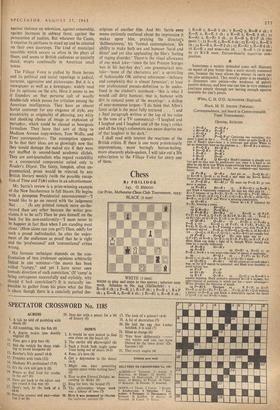Chess
By PIIILIDOR 245. 0. STOCCII1 (1st Prize, Melbourne Chess Club Tournament, 1953) BLACK (6 men)
WHITE (7 men)
WHITE to play and mate in two moves ; solution next week. Solution to No. 244 (Gallischek) : . . . R—B 6 ch ; 2 P—K 3!, R x P ch ; 3 P—B 3!, R x P ch ; 4 K—R 2, R—R 6 ch ; 5 K—Kt r, R-.--R 8 ch ; 273 K—B 2, R—B 8 ch ; 7 K—Q 3, R—B 6 ch ; 8 K—K 2, R—K 6 ch ; 9 K—B r, R—K 8 ch ; 50 K—Kt 2, R—Kt 8 ch ; ii K—B R x P ch (the point !) ; 12 K—K 2, R—K 6 ch ; r, R—K 8 ch ; 14 K—B 2, R—B 8 ch ; 15 K—Kt 3, R—B 6 ch ;
16 K—R a and wins—for r6 . . . 6 ch is met by 17 R x R mate. Extraordinarily ingenious com- position.
Sometimes a weakly defended game will illustrate an aspect of play better than a more sternly contested one, because the loser allows the winner to carry out his idea unimpeded. This week's game is an example ; it illustrates two points—the weakness of purely passive defence, and how 4one can lose in very cramped positions simply through not leaving enough squares available for one's pieces. White, C. H. 01). ALEXANDER (England). Black, M. H. SHEIKH (Pakistan). (Correspondence, 3rd board in Commonwealth Team Tournament).
Opening, SICILIAN.
1 P—K 4 2 Kt—K B 3 P—Q 3 3 P—Q 4 Px P 4 g P Q P— R 3? Contusing two variations: this move isiroxodin the 2 P—K 3 lines where an early Q—B 2 is part of Black's plan—here it is irrelevant and allows 'White to get an immediate bind on the position. 4 Kt—K B 3 is correct. 5 P—Q B4 Kt—K B 3
6 Kt—Q B 3 P—K 3
7 B—K 2 8—K2
8 0-0 0-0
9 B—K. Q Kr—Q 2 Black's position is already very bad and he may well he positionally lost, since it is hard to see what he can do to stop White steam-rollering him with his pawns. However, I think Kt—B 3 a little less cramped—and therefore better. ro P—B 4 Q—B .2 And not to . . P—Q Kt 3? it IQ ; Kt—B 6, —K ; 12 P—K 5 and wins the Kt—a drastic illustration of how cramped Black is. ii P—KKe4 Kr—Kr;? He must try P—Q Kt 3: text move is useless. P—Kt Kt—K s x2 .' . K Kr—Q z; 13 R—B 1, and Black is hopelessly congested. He dare not then play 13 ... Kt X P because of 14 BxKl, Q>13: 15 Kr—Q 5. P Kt (other- wise Kt x B ch); 16 R Q, P x R; 17 Kt—II 5, R—If x; Q—(2 4, B—B 1; 19 Q x B P, and White is winning comfortably. r3 Q—Kt 3 . . . Threat Ift x K P followed by
B x Kt, winning a pawn.
Kr—Q2 14 Q R—Q • P--Q Kt 3 P—K B 5 KC—B4 15 . Kt—K 4; 16 PXP, PxP; 27 P—B 5, Q PxP; 18 Ktx1". B . xKt(I8... 5; 19 Kt x Q); 19 Q x B ch, K xR r; 20 Kt—Q s_and wins. 16 Q—B 2 Q—Kt 2 I6 . 13—Kt 2; 17 P—Kt 4, P—K 4 (r7Kt—Q 2; 18 PXP); r8 P x Kt, P X Kt; 19 P X Kt P. Q xi; 20 B x P winning a pawn ianil with P—K B 6 to follow) and 16 . . P—K 4; 17 Kt—Q 5, Q—Kt 2; 18 Kt—B 61 (17 Q—Q 2; 18 Kt x P, Q—Q ; 19 Kt-13 6!) are equally bad. /7 P—K s P._.--Q4? His only hope was 17 . QPxP!; is 11—B 3, 4.4—IS 2; 19 fixR,PxKt; 20 RxP,Px.P, when Black can make a fight of it, though White should win. Now he is rapidly suffocated. r8 B—B 3 Kt—B 2 so P—B 6' . 19 Q—Kt 2, R—Q I; 20 P—B 6, B—B is less good—the order of moves is important. B—V 19 . — P P?; 20 Kt PXP, B— ; 21 Q--Kt 2 ch, —R 1; 22 Q—Kt 7 mate. 20 Q—Kt 1 R—Kt r All the pieces arc in each other's way, so the Q P cannot be protected and Black tries therefore to avoid further loss.
21 PxP Kt x P 12 KtxKr
PxKt 23 BxP
Q--B 2 23 . . Q—Q 2; 24 Kt.—B 6 is equally hopeless. Black probably expected Kt—B 6 anyway, but now—typical of positions in which one has a space advantage— White switches the direction of attack. 24 P---Kt 6 Resigns 24 . . . R P xP; 25 Q x P. Kt—K 3; 26 Kt x Kt, P x Kt (26 P x Q; 27 Kt x Q eh winning a piece); 27 B—K 4, and Black is defenceless against the threat of Q—R 7 eh and B—Kt 6 mate.






























 Previous page
Previous page